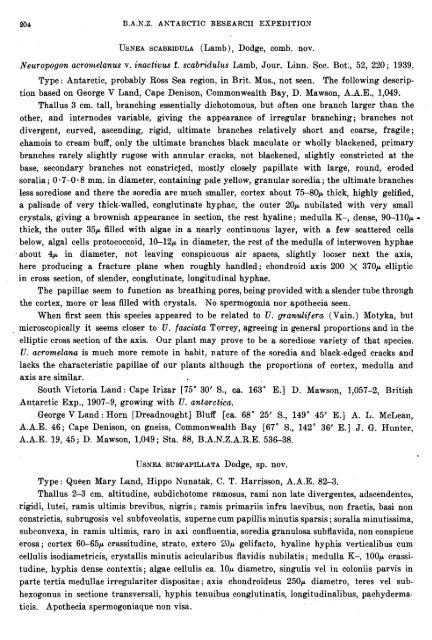Create successful ePaper yourself
Turn your PDF publications into a flip-book with our unique Google optimized e-Paper software.
B.A.X.Z. ANTARCTIC BESEARCII ESPEDI'rJON<br />
USNEA SCABRIDULA (Lamb), Dodge, comb. nov.<br />
Neuropogon acronaelamus v. imcti.u.vw f. scabridulz~s Lamb, Jour. Linn. Soc. Bot;, 52, 220 ; 1939.<br />
Type: Antarctic, probably Ross Sea region, in Brit. Mus., not seen. The following description<br />
based on George V Land, Cape Denison, Commonwealth Bay, D. Mawson, A.A.E., 1,049.<br />
Thallus 3 cm. tall, branching essentially dichotomous, but often one branch larger than the<br />
other, and internodes variable, giving the appearance of irregular branching; branches not<br />
divergent, curved, ascending, rigid, ultimate branches relatively short and coarse, fragile;<br />
chamois to cream buff, only the ultimate branches black maculate or wholly blackened, primary<br />
branches rarely slightly rugose with annular cracks, not blackened, slightly constricted at the<br />
base, secondary branches not constricjed, mostly closely papillate with large, round, eroded<br />
soralia; 0.7-0.8 mm. in diameter, containing pale yellow, granular soredia; the ultimate branches<br />
less sorediose and there the soredia are much smaller, cortex about 75-8OP thick, highly gelified,<br />
a palisade of very thick-walled, conglutinate hyphae, the outer 2OP nubilated with very small<br />
crystals, giving a brownish appearance in section, the rest hyaline; medulla K-, dense, 90-110~ -<br />
thick, the outer 35,~ filled with algae in a nearly continuous layer, with a few scattered cells<br />
below, algal cells protococcoid, 10-12p in diameter, the rest of the medulla of interwoven hyphae<br />
,about 4~ in diameter, not leaving conspicuous air spaces, slightly looser next the axis,<br />
here producing a fracture plane when roughly handled; chondroid axis 200 X 370,~ elliptic<br />
in cross section, of slender, conglutinate, longitudinal hyphae.<br />
The papillae seem to function as breathing pores, being provided with a slender tube throngh<br />
the cortex, more or less filled with crystals. No spermogonia nor apothecia seen.<br />
When first seen this species appeared to be related to U. g.radifera (Vain.) Motyka, but<br />
microscopically it seems closer to U. fasciata Torrey, agreeing in general proportions and in the<br />
elliptic cross section of the axis. Our plant may prove to be a sorediose variety of that species.<br />
U. acromelanu is much more remote in habit, nature of the soredia and black-edged cracks and<br />
lacks the characteristic papillae of our plants although the proportions of cortex, medulla and<br />
axis are similar.<br />
South Victoria Land: Cape Irizar [75" 30' S., ca. 163" E.] D. Mawson, 1,057-2, British<br />
Antarctic Exp., 1907-9, growing with U. antarctica.<br />
George V Land: Horn [Dreadnought] Bluff [ca. 68" 25' S., 149" 45' E.] -4. L. McLean,<br />
A.A.E. 46; Cape Denison, on gneiss, Commonwealth Bag [67" S., 142" 36' E.] J. G. Hunter,<br />
A.A.E. 19, 45; D. Mawson, 1,049; Sta. 88, B.A.N.Z.A.R.E. 536-38.<br />
USNU SUBPAPILLATA Dodge, sp. nov.<br />
Type: Queen Mary Land, Hippo Nunatak, C. T. Harrisson, A.A.E. 82-3.<br />
Thallus 2-3 cm. altitudine, subdichotome ramosus, rami non late divergentes, adscendentes,<br />
rigidi, lutei, ramis ultimis brevibus, nigris; ramis primariis infra laevibus, non fractis, basi non<br />
constrictis, subrugosis vel subfoveolatis, superne cum papillis minutis sparsis ; soralia minutissima,<br />
subronvexa, in ramis ultimis, raro in axi conflnentia, soredia granulosa subflavida, non conspicue<br />
erosa; cortex 60-65p crassitudine, strato, extero 2Jp gelifacto, hyaline hyphis verticalibus cum<br />
cellulis isodiametricis, crystallis minutis acicularibus flavidis nubilatis; medulla K-, 1OOp crassi-<br />
tudine, hyphis dense contextis; algae cellulis ca. lop diametro, singulis vel in coloniis parvis in<br />
parte tertia medullae irregulariter dispositae: axis chondroideus 250p diametro, teres vel sub-<br />
hexogonus in sectione transversali, hyphis tenuibus conglutinatis, longitudinalibus, pachyderma-<br />
ticis. Apothecia spermogoniaque non visa.

















